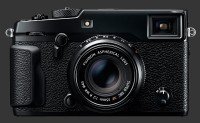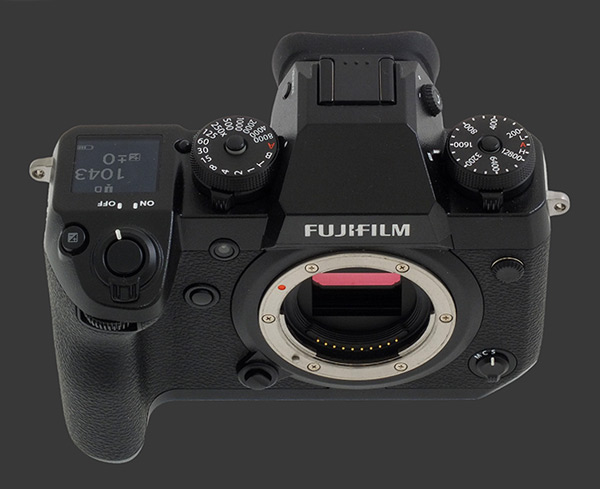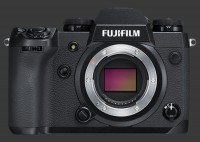Fujifilm X-H1 Review
Fujifilm X-H1 Performance - How well does it take pictures?
Performance starts with image quality, which is the criteria used as the foundation of our digital camera ratings. Ergonomic issues may get in the way, but in the end, image quality counts the most. For an ILC, image quality greatly depends on the lens used. While color, noise, exposure and dynamic-range are properties of a camera, distortion, vignetting and chromatic aberrations are properties of the lens. Sharpness and contrast depend on the weakest link. That is, a camera cannot capture more details than a lens lets through. Conversely, it is quite possible for a lens to transmit more details than a sensor can capture.

Image Noise & Details
Given that the Fujifilm X-H1 shares its 24 megapixels X-Trans CMOS III sensor with other Fujifilm mirrorless starting with the X-Pro2
Fujifilm X-Pro2, it is completely expected to deliver image-quality comparable to the best APS-C cameras currently available. Image processing has been improved furthermore since this sensor was launched which improves image-quality yet again. The step is obviously small but important as other cameras are improving too.
With 24 megapixels and no anti-alias filter, the X-H1 can capture very fine details and delivers very good per-pixel sharpness, only being surpassed by a few lower resolution models. Its pixels are smallest among APS-C cameras and so this model is quite sensitive to lens performance and hits the diffraction limit rather early on.
ISO 100 to 800 are perfectly smooth and usable for rather large prints that can stand critical inspection. From ISO 100 to 800 though, maximum-sized prints look absolutely perfect. Image noise is nearly invisible until ISO 1600 where it starts appearing when viewed at 100%. Still, large prints are completely usable by any measure.
ISO 3200 shows some light noise and accompanying loss of details due to noise-reduction. The impact of this is low yet it reduces maximum print sizes a little. Mid-size prints such as 15" x 10" still come out looking very good. Dynamic-range takes a slight hit here but color and contrast are surprisingly well-maintained at this sensitivity.
Unsurprisingly, the trend continues at ISO 6400. Noise increases a little and more details start being eaten away by it. One can still make a fairly nice mid-size print up to 12" x 8". ISO 12800 gets both nosier and softer which reduces print sizes further yet not by that much. This is the last of the standard sensitivity range of the Fujifilm X-H1.
The expanded ISO 25600 setting remains usable for small prints. This is very good performance. Colors and contrast are still well-maintained even that such a high ISO. The finest details are gone by then but once shrunk to a small size will appear very reasonable. The final expanded ISO of 51200 is actually usable for small prints and web-use.
Sharpness is controllable in 9 levels. Things start from a very soft to over-sharp, so each step is quite coarse. The default level leaves a little softness and one above adds a touch of sharpness with minimal artifacts. Recall that the X-Trans CMOS III sensor has no Anti-Alias Filter and is not prone to moire either, so it is capable of capturing very fine details.

Color & White Balance
Color accuracy of the X-H1 is very good. Hues are realistic with Film Simulation modes mostly affecting saturation. The Provia film simulation gives a very natural rendition of colors. Fujifilm is renowned for their expertise in color. The X-H1 offers a high number of Film Simulation modes to cater to different tastes. Each one is further adjustable with 9 levels of saturation, where the default is set right in the middle which works out to realistic colors for Provia.
Fujifilm appears to have revised the Automatic White-Balance algorithm in the X-H1. It delivers a very good performance, rendering most scenes with neutral colors even down to very low-light levels. There is occasionally in bluish tint when shooting images dominated by a lot of sky which can easily be corrected by using Preset or Custom White-Balance options. When light is very low, the camera is not capable of sampling for Custom White-Balance, so one can fall back to manually tuning WB in Kelvin units. While not perfect, it definitely delivers on of the best White-Balance performance among mirrorless digital cameras.
Exposure & Dynamic-Range
The Multi-Segment metering system of the X-H1 is generally quite reliable. It is generally quite conservative and rarely blows out highlights unless they are rather small. Exposure is often spot-on for scenes of moderate to high-contrast, which means that they may turn out fairly dark in the presence of bright highlights. Scenes of low-contrast tend to get under-exposed and require more positive compensation than usual, particularly when dominated by slight colors from snow or white paint.
Since the X-H1 does not usually show an Exposure-Priority preview, it tends to display images brighter than they will come out. This causes the EVF and LCD to appear overblown while pictures taken are actually fine. The opposite happens sometimes though when capturing heavily colored subjects such as colorful flowers. In this case it is possible that the preview looks good, including the Live-Histogram which shows a single-channel, yet the capture image has one of its channels clipped.
In addition to the Multi-Segment metering mode, this camera offers Center-Weighed, Spot and Average modes. Center-Weighed is a less sophisticated version of Multi-Segment and much more prone to overexposing the background. Spot and Average metering work just as expected.
All Fujifilm mirrorless camera have controllable Dynamic-Range. At its native sensitivity of ISO 200, the camera is set to capture a normal dynamic range which is referred to as 100% DR. While this setting does not change at Low ISO 100, there is clearly a loss of dynamic-range at that sensitivity. Starting at ISO 400, the X-H1 allows 200% DR to capture twice the dynamic-range. This gives it a dynamic-range comparable to top-of-the-line APS-C digital cameras. From ISO 800 to 12800, it is possible to select 400% DR which captures 2 stops more dynamic-range than the standard level. At that level dynamic-range is truly exceptional for an APS-C sensor.
New to the Fujifilm X-H1 is Dynamic-Range Priority mode. This selects between 100% and 400% Dynamic-Range depending on measurements taken by the metering system which reduces blown highlights in scenes of high-contrast since extra dynamic-range is always added in highlights rather than shadows. Note that this is not very different than simply selecting 400% Dynamic-Range since the camera will reduce it to 200% or 100% when the chosen dynamic-range is unavailable.

Auto Focus
The X-Trans CMOS III sensor in the X-H1 features a hybrid 325-Point Autofocus system. The camera combines Phase-Detect and Contrast-Detect information plus subject recognition to track focus across most of the frame, over 75% of each dimension. A 91-Point grid of Phase-Detect sensors covers 75% of the vertical image area and 50% of the horizontal one. Contrast-Detect points complete the set.
Autofocus on the X-H1 is fast and quite sensitive. It can lock focus down to -1 EV which is 1½-stops better than the X-T20 using the same sensor. The new algorithm delivers better sensitivity, although with very occasional focus misses and slightly longer AF-lock speed when light is dim. The extra sensitivity allows the X-H1 to work with apertures down to F/11, while only F/8 was previously possible.
While this digital camera can focus extremely quickly. the autofocus algorithm takes depth-of-field into account, so it slows down noticeably at close range where depth-of-focus is shallower. This makes autofocus acquisition speed extremely variable from under ¼s to over 1s for macro photography. The newest lenses such as the Fujinon XF 80mm F/2.8R LM OIS WR feature a focus-limiter switch to reduce the AF searching range.
The Continuous AF system in the Fujifilm X-H1 is impressive. It can track subjects moving at moderate speed even down to relatively low light. There are continuous focus modes to track different types of motion: Standard, Obstacle, Acceleration, Frame Entry and Erratic Movement. While one can select Continuous AF independently or drive speed, the X-H1 alone cannot keep AF locked at high-speed. With the optional grip and Boost enabled, it impressively manages to keep AF locked at a full 14 FPS!

Speed
The Fujifilm X-H1 is an extremely fast digital camera. It can shoot continuously at up to 14 FPS for up to 40 JPEG images or 27 RAW files. This is possible only with the Electronic Shutter which is completely silent. The still highly-impressive speed of 11 FPS is possible with the Electronic-Shutter too or with a Mechanical-Shutter when using the VPB-XH1 grip. At this speed, the number of frames increases to 70 JPEG or 28 RAW.
The top Mechanical-Shutter speed possible without the grip is 8 FPS. The buffer depth then becomes 80 JPEG images or 31 RAW files. Going down to the medium continuous drive of 6 FPS, an unlimited number of JPEG images can be captured as long as there is storage left. The internal buffers clears very quickly when using a UHS-II memory card.
This mirrorless is quite responsive. Nearly all actions occur without delay. When enabled, the Instant Review is absolutely instantaneous. Too bad images cannot be deleted right there.
The following measurements characterize the performance of the Fuji X-H1:
- Power-On: 1¼s. Average..
- Power-On to First-Shot: 2s. Below average.
- Autofocus: ¼s-½ typically, up to1½s when close-focus in low-light. Good to slow.
- Shutter-lag: Instant with nearly no blackout. Excellent.
- Shot-to-shot: ¾s without grip, ½s with grip. Average.
- Playback: ½s to enter, 1s to exist. Below average.
- Power-Off: ¾s, including sensor cleaning. Very good.
- Video: Instant start but 1s delay to stop. Average.
While the camera itself is particularly responsive, its performance numbers fail to impress. Power on is slow for a professional level camera which affects the power-on-to-first-shot time. This camera also takes an unusual amount of time to wake up from sleep, so it only saves a little time compared to powering off. Switching between Capture and Playback mode is also below average.
Autofocus is highly variable. It can be very fast when light is good and the focus-distance is not too short. Having Boost mode enabled, really makes it much snappier. This is most noticeable in low-light where the X-H1 can normally take up to 1½s which becomes twice as fast with the grip in Boost mode. As mentioned earlier, Continuous AF speed is quite impressive. Once focus has been achieved though, there is no shutter-lag and virtually no blackout.
Shot-to-shot time is most disappointing considering the camera can capture 14 FPS, it does not even reach an average of 2 FPS in Single Drive mode. When it comes to continuous shooting though, this digital camera is rather fast with a good buffer-depth. Given it has a dedicated Video mode, the X-H1 is ready to shoot instantly. It takes a while to stop recording, missing the end by a full second.
The Fuji X-H1 is powered by a small proprietary Lithium-Ion battery which provides a paltry 310 shots-per-charge even without flash usage. This is one of the shortest battery-life of any mirrorless and is certainly limiting for professionals. The battery-grip improves this by allowing the use of 3 batteries which extends battery-life to something more reasonable. Still be prepared to change batteries often and constantly be charging. This is not the right camera to take off the grid.
Fujifilm X-H1 Performance - How well does it shoot video?
Fujifilm emphasized video features on the X-H1 and certainly shows on the specifications page. This is their first camera to shoot in Cinema 4K and 2K modes with 4096x2160 and 2048x1080 respectively. In those 17:9 aspect-ratio videos, the camera always shoots at 24 FPS. Standard 4K Ultra-HD is possible at 30 FPS while 1080p Full-HD can achieve 120 FPS. Four times less resolution at 4X the frame-rate means it uses exactly the same throughput either way.
There is quite a few choices of frame-rates from 24 to 120 FPS, depending on the limit imposed for the resolution. Videos are saved in proprietary Quicktime format with bit-rates of 200Mbps for Ultra-HD and Cinema 4K and either 100 Mbps or 50 Mbps at lower resolutions. This produces very high-quality videos with correspondingly large files to match.

Recognizing that photography and videography needs are not the same, the Fujifilm X-H1 offers separate configuration for Film Simulation, Dynamic-Range, White-Balance, Highlight Tone, Shadow Tone, Color, Sharpness and Noise-Reduction, Focus Area, Movie AF, MF-Assist, Face/Eye Detection, Focus-Check and Pre-AF. Additionally video can be stored as F-Log and Peripheral Light Correction is available for video only.
Audio is highly configurable with Auto, Manual or Disabled input. This is controllable separately for the internal stereo microphone or stereo audio input. In Manual input mode, the audio level can be adjust from -30 to +6 dB. There is also an Audio Limiter, a Wind Filter and a Low-Cut Filter.
Time Code is supported by the X-H1, a feature only normally found in serious video cameras. It can be displayed or not and the start time can be manually entered or taken from the internal clock. There is an option to include Time Code in the HDMI output too. The X-H1 is equipped with front and rear lights to indicate that the camera is recording. Settings include options to use the front, back, both or none in steady or blinking mode.
Video performance of the Fujifilm X-H1 is almost impeccable. Output quality is exceptional with virtually no compression artifacts at high bit-rates. The camera starts recording instantly but leaves an extra second in videos after stopping. Truly a minor issue which is easy to correct using video editing software. The electronic shutter is read very quickly which minimized rolling-shutter artifacts.
Fujifilm X-H1 Conclusion

The Fujifilm X-H1 takes a proven 24 megapixels X-Trans CMOS III sensor and fits it on a state-of-the-art 5-axis image-stabilization mechanism. While it falls short of the 5½ stops claimed in specifications, it delivers a solid 2½ stops of improvement over hand-holding any other Fujifilm mirrorless. This improves the low-light capabilities of the platform which can now focus down to -1 EV with its 325-Point Hybrid Autofocus system.
For the first time, Fujifilm emphasized video features in a digital camera and the X-H1 really delivers on that front. It captures extremely detailed videos with virtually no artifacts from Cinema 4K at 24 FPS to Full HD at 120 FPS, even adding a 17:9 extra-wide 2K video to the mix. Audio options are plentiful and it also supports Time Code and F-Log recording.
Image quality from the X-H1 is top-notch as one would expect from this sensor. Rendering has further been improved to maintain fine-details, dynamic-range and contrast as ISO increases. This camera delivers output which is highly competitive with very little noise until ISO 1600 and a really broad dynamic-range. Maximum print sizes diminish as sensitivity is increased yet the output remains usable throughout the Expanded ISO range.
Metering, Color and White-Balance are among the best-in-class and all highly reliable. The combined Phase-Detect and Contrast-Detect AF system can perform very well in good to moderate light yet shows some occasional focus-missed when light is low. The speed of this system is highly variable too with ultra-fast focusing in good light but performance slows down dramatically at close-focusing distances. The best AF performance of the X-H1 though comes from its Continuous AF system that even manages to keep up with the Continuous Drive when using the optional grip.
Speed of the X-H1 is mixed. The Continuous Drive modes are stellar and so are the shutter-delay and blackout times. Things oddly slow down though when it comes to shot-to-shot speed and Playback mode. The optional grip gives this camera a solid boost in many areas that take average performance numbers and turns them into good ones. Many aspects stay the same however. Battery-life of the X-H1 is truly limited.
With a design right between the X-T2 and Medium-Format GFX 50S, this mirrorless digital camera inherits a highly tactile feel. There are dials for everything and many ways of controlling parameters. This makes the whole camera rather complex despite having so many direct controls. The shutter-release takes a while to get used to but minimized camera shake. The new ultra-high-resolution EVF is incredibly sharp and refreshes very quickly.
This is a digital camera that leaves mixed feelings. While image and video quality can only be praised, the mixed performance and the inability of the autofocus system to match its predecessor is disappointing. Ergonomics that were so nearly perfect on the X-T20 did not follow on the X-H1 and many controls are now either inefficient or accident-prone. At the same time, the Fujifilm X-H1 is one of the largest and most expensive cropped-sensor mirrorless camera on the market.
 |
Please Support Neocamera
All information on Neocamera is provided free of charge yet running this website is a huge endeavor. Purchases made via affiliate links found throughout the site help keep it running and up-to-date. There is no additional cost to you, so please consider buying via these links to our affilates:
If you found any information on this site valuable and did not purchase via our affiliate links, please considering donating via PayPal:
Any amount will be greatly appreaciated. Thank you for your support!
Fujifilm X-H1 Highlights

Sensor-Size: 24 x 16mm

Actual size when viewed at 100 DPI
| 24 Megapixels Mirrorless | ISO 100-51200 |
| Fujifilm X Mount 1.5X FLM | Shutter 1/32000-30s |
| 5-Axis Built-in Stabilization, 5.5-Stop Improvement | Full manual controls, including Manual Focus |
| 0.50" Built-in EVF 3.7 Megapixels (0.75X) | Custom white-balance with 2 axis fine-tuning |
| Automatic Eye-Start sensor | Spot-Metering |
| 2 Axis Digital Level | Hot-Shoe & Sync-Port |
| Weatherproof down to -10C | Stereo audio input |
| Built-in Dust Reduction | Lithium-Ion Battery |
| 14 FPS Drive, 40 Images | Secure Digital Extended Capacity x 2 |
| 4096x2160 @ 24 FPS Video Recording | |
| 3" LCD 1 Megapixels |
Updates
2024.11.18

Best 2024 Photography Gifts for Every Budget
Great gifts for photographers and photo enthusiasts selected for every budget among the best products of 2024.
2024.08.07

Eye Protection Tips for Professional Photographers
The four main considerations for professional photographers regarding eyewear.
2024.07.14

Fujifilm X100VI Review
Flagship fixed-lens compact digital camera with a 40 MP sensor and Image-Stabilization, a first for the series. Retro design featuring dual control-dials, plus direct ISO, Shutter-Speed and EC dials. Its hybrid viewfinder can switch between EVF and OVF mode.
2024.05.09

Fujifilm GFX100 II Review
Flagship 102 Megapixels Medium-Format Mirrorless Digital Camera with 8-Stop 5-Axis IBIS, 8 FPS Drive, 8K Video and 400 MP Super-Resolution capture in a weatherproof and freezeproof body with dual control-dials and dual memory-card slots.
2024.04.03

Fujifilm X-T5 Review
Newest Fujifilm flagship boasting a 40 MP APS-C sensor, 5-axis IBIS with 7-stop efficiency, 15 FPS continuous drive, 6.2K Video capture, dual control-dials and dual SDXC UHS-II slots in a sturdy weatherproof and freezeproof body.
2023.11.20

Best Digital Cameras of 2023
Find out which are the Best Digital Cameras of 2023. All the new Mirrorless Digital Cameras from entry-level to high-end professional.
2023.07.10

Fujifilm X-H2 Review
40 Megapixels APS-C Hybrid Mirrorless Digital Camera with 7-stop IBIS. Fastest shutter ever and 8K video capture. Large builtin EVF with 0.8X magnification and 5.8 MP, plus an Eye-Start Sensor. Packed with features and large number of controls in a weatherproof and freezeproof body.
2023.05.07

Sony FE 20-70mm F/4G Review
Review of the unique Sony FE 20-70mm F/4G lens. The optical zoom of this lens spans ultra-wide-angle and medium focal-length coverage, making it one of the most versatile Full-Frame lenses on the market.
2023.01.15

Huion Inspiroy Dial 2 Review
Review of the Huion Inspiroy Dial 2 tablet, a medium sized drawing surface with dual dials and customizable buttons. Connects via USB-C or Bluetooth 5.0 with Windows, Linux and Android support.
2022.12.08

How to Pack for a Photo Trip
Find out how to pack for a travel photography trip, carry your gear safely while meeting airline regulations.
2022.11.13

Best Digital Cameras of 2022
The best digital cameras of 2022. A short list of the most outstanding models in their respective categories. Choose one for yourself or as a gift.
2022.09.21

Pentax DA* 60-250mm F/4 SDM Review
Review of the Pentax DA* 60-250mm F/4 SDM, the constant-aperture telephoto zoom with the highest zoom-ratio on the market.












